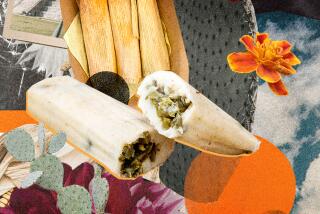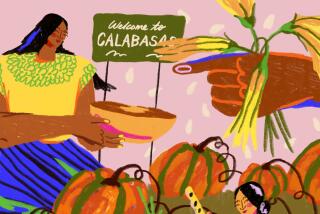Chiles’ kick is an old story, scientists find
- Share via
Thousands of years before ketchup, mayonnaise or Grey Poupon, there was the red-hot chile pepper.
Researchers have found evidence that farmers in the Americas, stretching from the Bahamas to Panama to Peru, domesticated the spicy fruit about 6,100 years ago, making it perhaps the oldest condiment in the history of cooking.
The scientists were surprised to find that those early agricultural societies had advanced to the point of cultivating more than staples such as maize, yams, beans and cassava.
“This is an indication that there was a complex system of agriculture and sophisticated cuisine very early, even before pottery in some places,” said Linda Perry, a postdoctoral research fellow at the Smithsonian’s National Museum of Natural History and leader of the study, published today in the journal Science.
Perry and other food archeologists found microscopic fossils of chile starches on milling stones, cooking vessels and even in the dirt at seven early settlements in the New World.
The oldest fossils were found in two village-sized settlements in southwestern Ecuador that were first occupied about 6,100 years ago.
The fossils have a distinctive shape, resembling jelly doughnuts whose centers were squashed on both sides. But it took several years to identify what had left them behind.
Scientists suspected a starchy food, but none of the usual suspects -- maize, potatoes, yams or cassava -- produced the telltale shape.
Then an offhand comment about peppers causing digestive problems led Perry to consider them as a candidate.
“My first thought was, ‘That’s odd, things like that are usually caused by undigested starches,’ ” she said. “Then, bing! The light bulb goes off.”
Scientists can only guess when chiles were first domesticated from wild capsicum plants, which originated in Bolivia. Perry says she suspects that peppers are as old as maize -- domesticated 9,000 years ago -- because both plants were found at every site the scientists examined.
It’s likely that chiles were the first condiments to be domesticated, even though agriculture developed earlier in the Middle East than in the Americas, said Greg Anderson, an evolutionary botanist at the University of Connecticut, who was not involved in the study. Their bright color and desirability among birds would have made them stand out to humans, he said.
“Given how popular it is to modern humans, why wouldn’t it have been just as popular to ancient humans who were trying to make their diet a little more interesting?” Perry said.
Chiles are rich in vitamin C, so ancient people who ate them would have gained a nutritional advantage over those who didn’t, said Scott Raymond, a University of Calgary archeologist and coauthor of the study. Chiles also might have contributed to humans’ nutrition by helping them consume more of their staple foods.
Chiles are “an excellent disguiser,” he said. “If something’s not tasting quite right, you can always throw a few chiles in the pot.”







